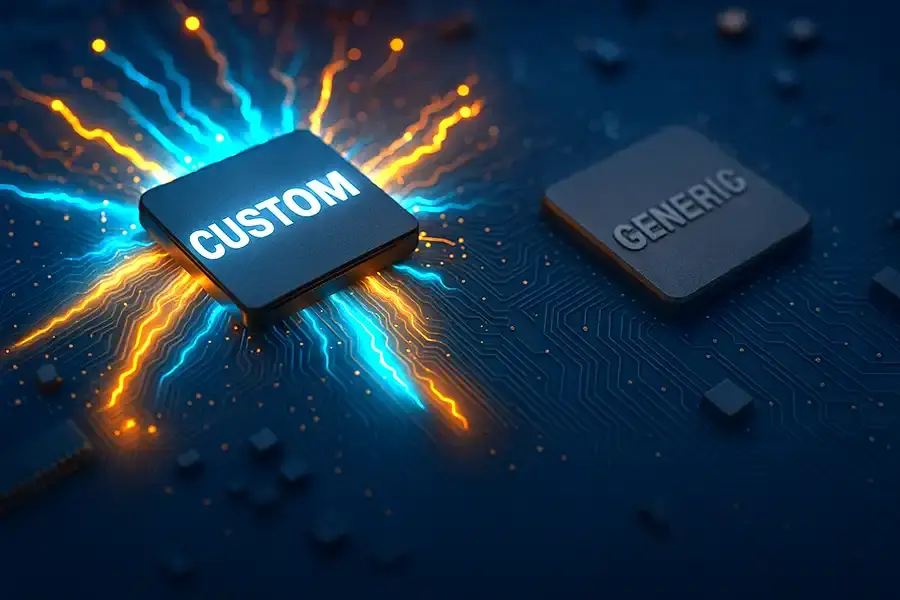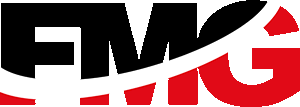The Real Difference Between Custom and Off-the-Shelf AI Tools

Why Industrial Companies Need AI Infrastructure — Not Just AI Features
Walk through most modern software today, and you'll see AI everywhere. There's an "Ask AI" search bar here, an auto-generated summary there, and a chatbot tucked into the corner of a screen. These additions can make a product feel modern, but in most cases, they are powered by off-the-shelf AI: general-purpose models wired into tools that promise quick wins with minimal configuration.
For simple questions and basic workflows, that's often enough. But for industrial and technical companies—where products are complex, applications are demanding, and decision-making involves real consequences—that approach breaks down quickly. You don't just need AI sprinkled around the user interface. You need AI that understands your world: your engineering constraints, your product logic, your documentation, and the workflows your teams rely on every day.
Most importantly, you need AI that doesn't behave like a feature, but like infrastructure—embedded into the enterprise, supporting real decisions and operations across multiple departments. And that is where the real difference between off-the-shelf AI and custom AI emerges.
Off-the-Shelf AI: Intelligent, but Shallow
Off-the-shelf AI is designed to be broadly applicable and instantly deployable. It shows up as an add-on to your CRM, a "draft this message" button in your support platform, or a generic chatbot that sits on your website. These tools are easy to activate: connect an account, adjust a few settings, point the AI toward basic content, and you're done.
Underneath that convenience, however, is a significant limitation. Off-the-shelf AI is trained on broad public data, not the specifics of your product architecture or the reasoning behind your engineering rules. It can respond fluidly to general language but knows nothing about how your product families are structured, what configurations are allowed, or what environmental ratings apply to specific applications.
For straightforward, low-stakes tasks—summarizing text, drafting routine emails, navigating FAQs—generic AI performs well. But when the questions become technical, contextual, or dependent on internal knowledge, it delivers surface-level intelligence and little more.
Custom AI: Intelligence Integrated Into the Business
Custom AI takes an entirely different approach. Instead of starting with a general-purpose model and asking, "What can this do for us?", custom AI begins with your real-world processes and asks, "Where should intelligence live inside our business?" That shift changes everything.
Custom AI examines how decisions are made across departments: how sales qualify and configure solutions, how engineering validates technical fit, how support diagnoses customer issues, and how operations processes information or approves tasks. It identifies where work slows down, where teams repeat the same steps, and where expertise is trapped in documents or individual knowledge holders.
From there, AI isn't added on top of existing workflows—it's woven directly into them. A custom system can guide product selection using engineering rules, help internal teams find accurate documentation instantly, read and interpret manuals or drawings, route and categorize incoming requests, or synchronize decisions with ERP and CRM systems. Instead of becoming another tool in the sidebar, custom AI becomes part of the organization's infrastructure. It transforms from a helper to a system-level capability.
From Surface Intelligence to System-Level Intelligence
The difference between the two approaches can be summed up as follows: off-the-shelf AI sits at the edges of your business, while custom AI operates at its core.
Off-the-shelf AI reacts to text in isolation. It doesn't understand relationships between product families, why specific configurations are prohibited, or what documentation governs a particular solution. It can't interpret nuanced descriptions of customer applications, and it certainly can't take action in your systems.
Custom AI can. By connecting to your product data, technical content, decision logic, and historical examples, it develops the kind of contextual understanding required to make recommendations that align with real engineering constraints. It knows which configurations make sense, which options require certifications, which exceptions are allowed, and when a customer is describing a specific scenario, even if they don't use your terminology.
That deeper understanding enables something generic AI cannot provide: intelligence that supports action—creating records, routing requests, enriching leads, validating configurations, or initiating next steps in a workflow. This is where AI stops being a feature and becomes infrastructure.
Beyond Customer-Facing Tools: AI for the Entire Enterprise
AI is often imagined as a customer-facing chatbot, but for industrial companies, the most significant value usually lies internally. Sales teams need quick access to relevant past examples. Support teams need to search across years of documentation and ticket histories. Engineering teams need protection from repetitive questions that distract from higher-value work. Operations teams need clarity, consistency, and reduced manual effort.
A custom-trained AI assistant—powered by your manuals, ToolDocs™ library, engineering notes, proposals, specifications, and historical project data—can serve all of these teams. It becomes a shared knowledge layer across the enterprise, giving departments faster answers, better context, and more consistent decision support.
This cross-department impact is what elevates custom AI from a "tool" to an internal infrastructure that improves operational efficiency company-wide.
Governance, Reliability, and Organizational Confidence
In industries where accuracy matters, governance isn't optional. Off-the-shelf AI provides only limited control over its behavior. You can add a few instructions or guardrails, but you cannot shape how the model reasons or what information it draws from.
Custom AI allows for deliberate governance. You can define which data sources are permitted, when the system should escalate or refuse to answer, how conservative or assertive its reasoning should be, what level of traceability is required, and when a human must review a decision. Over time, teams develop confidence in the system because its behavior is designed—not improvised.
This confidence is essential for organizational change management. When people know what the AI can handle, when it should defer, and why it responds the way it does, adoption becomes natural instead of forced.
When Off-the-Shelf AI Is Enough
Off-the-shelf AI still has an important place. For low-risk, low-pressure tasks—drafting content, summarizing documents, organizing information, or answering simple questions—generic tools provide fast value with minimal effort. When the goal is convenience rather than integration or accuracy, these tools excel.
But the moment you require depth, technical precision, workflow alignment, or system-level control, the limitations become clear.
When Custom AI Becomes the Right Decision
Custom AI becomes the right investment when complexity, stakes, and scale intersect. Industrial companies rely on technical documentation, repeatable logic, regulatory constraints, and expert-driven workflows. In these environments, wrong answers are costly, and slow processes are painful.
Here, generic AI often looks impressive in demos but underdelivers in actual daily use. Custom AI, by contrast, becomes part of the organization's infrastructure—a consistent, governed, deeply informed layer of intelligence that enhances how teams operate and how customers interact with the business. It amplifies expertise, reduces friction, and strengthens the workflows that drive revenue and support.
That's the real difference: off-the-shelf AI gives you generic intelligence. Custom AI gives you aligned intelligence—intelligence that understands your products, rules, constraints, and users.
And for industrial and technical companies, that difference determines whether AI functions as a novelty… or becomes a competitive advantage.
